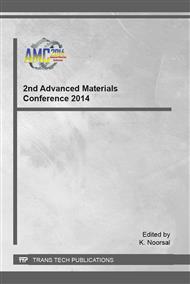p.486
p.491
p.496
p.501
p.505
p.510
p.515
p.523
p.527
Morphology and Structural Characteristic of Nanocrystalline Cellulose (NCC) Hydrolyzed from Filter Paper
Abstract:
The aim of this study was to study the morphology and structural characteristic of NCC hydrolyzed from filter paper. The NCCs were extracted by acid hydrolysis at 50°C for 1 hour, using 55% conc. H2SO4 under vigorous mechanical stirring, centrifugation at 12000 rpm in distillate water and followed by homogenizing at 7000 rpm. The morphology and surface profiles of the NCC suspension was characterized using field emission scanning electron microscopy (FESEM), transmission electron microscopy (TEM) and atomic force microscopy (AFM). The crystalline structure of the NCC was evaluated by using X-ray diffraction (XRD) technique. As a result, hydrolysed NCC was found to have a rod liked shape with diameter in the range of 100-300nm length and 10-50nm width, with the aspect ratio value of 10.3 nm. According to XRD investigations, the semi-crystalline cellulose was observed with the presence of an amorphous broad hump and crystalline peaks at 2θ of 15o and 22.7o, respectively. The crystalinity index of the raw filter paper was calculated as 86.7 % and increased to 94.4 % as it was extracted to NCC. Crystallite size of raw filter paper and NCC was calculated as 20.6 nm and 11.4 nm, respectively
Info:
Periodical:
Pages:
505-509
Citation:
Online since:
January 2016
Keywords:
Price:
Сopyright:
© 2016 Trans Tech Publications Ltd. All Rights Reserved
Share:
Citation:


